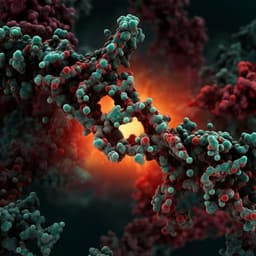
Biology
Transposase-assisted target-site integration for efficient plant genome engineering
P. Liu, K. Panda, et al.
Discover a groundbreaking genome engineering tool that harnesses the power of transposable elements to safely and accurately insert DNA into plant genomes. Led by researchers including Peng Liu and Kaushik Panda from the Donald Danforth Plant Science Center, this innovative system offers a leap forward in agricultural biotechnology.
Playback language: English
Introduction
Precisely inserting new DNA sequences into plant genomes is crucial for developing improved crops. Traditional methods, like random transgene integration, often lead to unintended mutations and unpredictable transgene expression due to position effects. While techniques like homologous recombination (HR) exist, their extremely low efficiency renders them impractical. Programmable nucleases, such as CRISPR-Cas9, offer improved targeted integration, but their success is still limited, particularly for larger insertions needed to encode complex traits. Prime editing can insert small sequences, but larger insertions remain challenging. Homology-directed repair (HDR) is another option, but it occurs infrequently in plants, with non-homologous end joining (NHEJ) being the dominant repair pathway, leading to frequent deletions and inaccurate insertions. The low frequency of successful targeted integration necessitates screening numerous transgenic plants, increasing costs and labor. This inefficiency hinders efforts to develop advanced crops using genome editing techniques. Transposable elements (TEs), also known as 'jumping genes', naturally insert their DNA into genomes with remarkable precision. Inspired by CRISPR-associated transposases in bacteria that enable programmable transposition, this research aimed to develop a novel system combining the targeting precision of CRISPR-Cas systems with the seamless integration capabilities of plant TEs to create a more efficient and accurate genome engineering platform for plants.
Literature Review
Previous attempts at site-specific gene integration in plants have involved various approaches, including HR, which is too inefficient for practical application. Programmable nuclease systems like CRISPR-Cas9 have improved targeted integration, but the success rates remain low and are further hindered when larger DNA insertions are required. Prime editing provides a means for small insertions, yet is limited in its cargo capacity. The use of HDR offers another avenue, however, it is often outcompeted by NHEJ in plants, causing frequent insertion errors. NHEJ knock-in strategies have been attempted, however, these frequently result in deletions of the flanking target-site DNA and/or the inserted sequence. These limitations highlight a significant need for improved technologies for targeted insertion in plant genomes, especially for larger DNA sequences encoding complex traits. The inherent precision of TEs in integrating their DNA into host genomes has attracted considerable attention. Class II DNA transposons, in particular, offer a unique 'cut-and-paste' mechanism. This process involves TE excision from a donor site, protection from degradation, and precise insertion at a new site. The choice of the integration site is influenced by several factors, including chromatin accessibility and the presence of short sequence motifs. Studies in bacteria have demonstrated the potential of CRISPR-associated transposases for programmable TE transposition, suggesting a promising strategy for plant genome engineering. However, the adaptation of such systems to plants has been challenging.
Methodology
This study fused the rice Pong transposase proteins (ORF1 and ORF2) with Cas9 or Cas12a programmable nucleases to create a system that combines CRISPR-guided targeting with TE-mediated insertion. A two-step transformation strategy was employed, using a pre-integrated mPing transposon within a GFP expression cassette (donor element) in Arabidopsis. The plant was then transformed with Pong-nuclease fusion proteins. Twelve different fusion protein transgene configurations were tested for mPing excision, assayed via GFP fluorescence and PCR. The functionality of the CRISPR-Cas9 system was validated through mutation detection assays at the PDS3 gene. Four PCR reactions were used to assay targeted mPing insertion at the PDS3 locus. Amplicon deep sequencing was used to analyze the precision of insertion junctions and assess the integrity of the inserted mPing element. Insertion sequencing (insertion-seq) was performed to determine the off-target insertion rate, comparing samples with and without the CRISPR-Cas system. The programmability of the system was demonstrated by targeting different genomic loci (ADH1 and ACT8) using different gRNAs. A single-component system was also developed where the mPing donor site was integrated into the same transgene as the ORF1/ORF2/Cas9/gRNA components. The rate of targeted insertion was compared between two-component and one-component systems. The cargo capacity was explored using modified mPing elements carrying different sequences, including enhancer elements (HSEs) and the herbicide resistance gene bar (in different configurations). The functionality of these inserted bar elements was tested in herbicide-resistance assays. Finally, the system was translated into soybean, a major crop plant, using different transgene configurations and targeting an intergenic region (DD20). Targeted insertions were assessed via PCR and Sanger sequencing. The integrity and functionality of the inserted cargo in soybean were also tested.
Key Findings
The researchers successfully generated a transposase-assisted targeted insertion system (TATSI) combining the targeting capability of CRISPR-Cas nucleases with the integration precision of transposable elements. In Arabidopsis, two configurations proved successful: ORF2-Cas9 fusion and unfused Cas9. The fused configuration showed decreased transposase activity but increased on-target insertions. Targeted insertions predominantly occurred at the CRISPR cleavage site or within 4 base pairs. The majority of inserted mPing elements were full length or near full length, indicating that the complete cargo was delivered. The rate of targeted insertion was significantly higher with TATSI compared to previously reported methods (HR, HDR, NHEJ knock-in). The system demonstrated programmability by targeting different loci and delivering various cargos, including enhancers and a bar gene expression cassette. In soybean, the unfused ORF2+Cas9 configuration achieved the highest rates of both mPing excision and targeted insertion. Targeted insertion of enhancer elements and the bar gene was also successful in soybean. The inserted bar gene conferred herbicide resistance in soybean, demonstrating its functionality. Insertion-seq analysis in both Arabidopsis and soybean showed that off-target insertions primarily resulted from free transposition events and not from off-target cleavage by CRISPR-Cas9, and were reduced in the presence of the Cas9 system. Overall, the TATSI system demonstrated higher efficiency and accuracy in targeted plant genome engineering compared to existing methods. A one-component system was successfully developed simplifying the genetic engineering process further.
Discussion
This study successfully demonstrated a novel approach for targeted genome editing in plants, achieving significant improvements over existing methods. The use of TEs, combined with the precision of CRISPR-Cas systems, significantly increased the rate and accuracy of targeted insertion. The observed higher fidelity of cargo integration in TATSI, compared to approaches like HITI, could be attributed to the continued protection of the TE's ends by the transposase proteins. The data suggests that mPing insertion is predominantly mediated by NHEJ. While small deletions and insertions at the insertion junctions were observed, these are generally tolerated in plant applications compared with medical or therapeutic applications. Although free transposition events still occur, they are less frequent than in the absence of CRISPR-Cas9. The higher efficiency of TATSI in soybean underscores its potential for practical applications in crop improvement. Although some off-target insertions occur, the introgression process in crop breeding often effectively removes these untargeted events. The relative tolerance of off-target insertions in crop production, combined with improved efficiency, suggests that TATSI represents a significant advancement.
Conclusion
This study successfully developed a novel transposase-assisted targeted insertion system (TATSI) for efficient and accurate plant genome engineering. TATSI demonstrated superior efficiency compared to existing methods in both Arabidopsis and soybean, particularly for larger DNA insertions. The system's programmability and cargo capacity were also highlighted. Future research could focus on optimizing the system to further reduce off-target insertions and enhance the control of insertion orientation. The ability of TATSI to deliver large DNA sequences including functional gene cassettes, opens up new avenues for improving various traits in diverse crop plants.
Limitations
While TATSI demonstrates significantly improved efficiency, some limitations remain. The system still produces some off-target insertions due to free transposition events. The orientation of the inserted mPing element is not controlled, and the efficiency of targeted insertion decreases with larger cargo sizes. Further optimization is needed to completely eliminate off-target events and enhance control over insertion orientation and larger cargo delivery.
Related Publications
Explore these studies to deepen your understanding of the subject.







